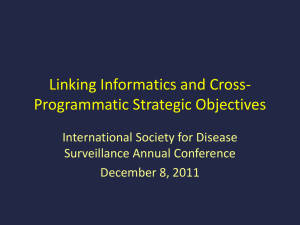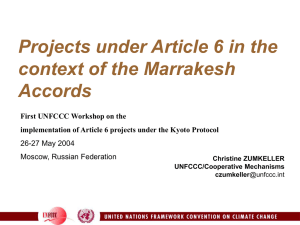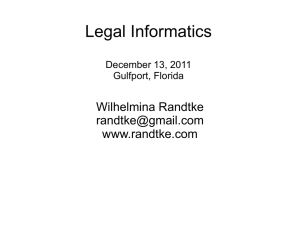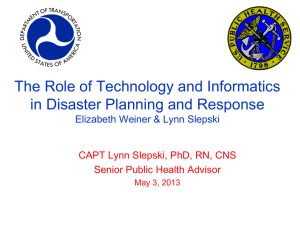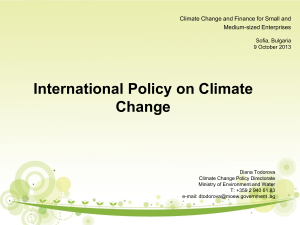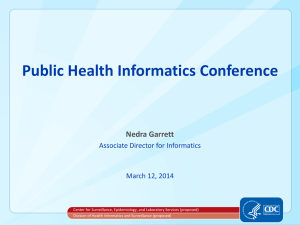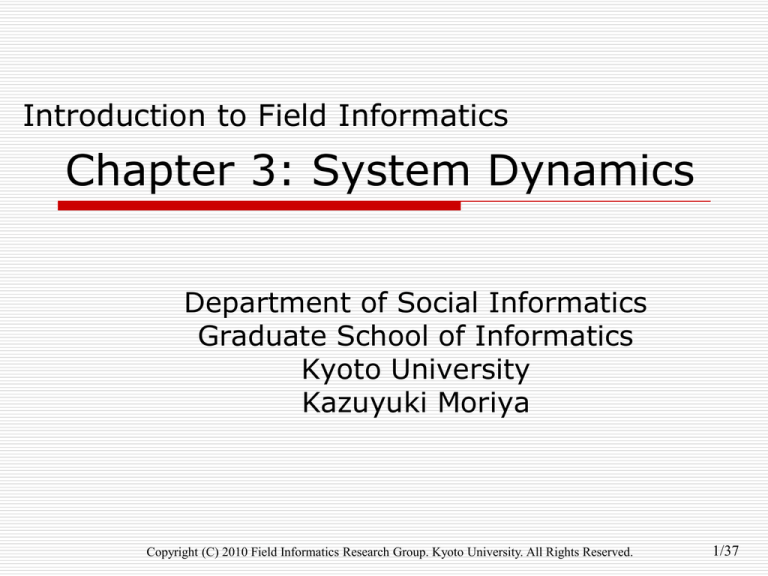
Introduction to Field Informatics
Chapter 3: System Dynamics
Department of Social Informatics
Graduate School of Informatics
Kyoto University
Kazuyuki Moriya
Copyright (C) 2010 Field Informatics Research Group. Kyoto University. All Rights Reserved.
1/37
What’s System Dynamics?
One of the numerical simulation techniques
Developed in the late 1950s by
J.W.Forrester of the Massachusetts
Institute of Technology
Applied the methodology for system
analysis used in engineering to dynamically
analyze systems in the field of business
administration and social science.
An effective tool for simulating and
analyzing complex systems in which various
factors are interrelated
Copyright (C) 2010 Field Informatics Research Group. Kyoto University. All Rights Reserved.
2/37
Simulation techniques
Deterministic Simulation
A given input always leads to the same
output under the mathematical model
Monte Carlo Method
Using random numbers and probability to
simulate problems.
Multi-agent simulation
Simulating the actions and interactions of
autonomous agents (both individual or
collective entities such as organizations or
groups) with a view to assessing their
effects on the system as a whole.
Copyright (C) 2010 Field Informatics Research Group. Kyoto University. All Rights Reserved.
3/37
How to Apply SD to Environmental
issue
Build a social model, in which some factors
related to ecosystem and human activities are
included, focusing on the flows of indicator
substances (such as carbon dioxide that is
considered as one of the causative factors of
global warming).
By executing models, you can grasp the
relationship among factors and the flows of
indicator substances not only through numerical
results but also by visualizing results with graphs.
SD can be used as a tool of decision making and
policy examination, because it is easy to compare
the results of various scenarios with SD models.
※SD:System Dinamics
Copyright (C) 2010 Field Informatics Research Group. Kyoto University. All Rights Reserved.
4/37
Application software
STELLA(isee systems inc)
STELLA supports a very intuitive
graphical user interface so that
beginners can easily use to learn about
SD.(paid)
Vensim
Software free for educational use, has
equivalent functions to STELLA.
Available from the website at
http://www.vensim.com/software.html.
Copyright (C) 2010 Field Informatics Research Group. Kyoto University. All Rights Reserved.
5/37
Elements of model components
Stock
A container where something is
stored.
Flow
A valve which controls the inflow to
or the outflow from a stock.
Converter
Used for defining the auxiliary
variables and constants.
Copyright (C) 2010 Field Informatics Research Group. Kyoto University. All Rights Reserved.
6/37
Symbols: Stock, Flow and Converter
Stock
Converter
Flow
The flow of information among
elements can be described by
connecting stocks and flows to one
another with connectors.
※An Arrow(→) stands for a connector.
Copyright (C) 2010 Field Informatics Research Group. Kyoto University. All Rights Reserved.
7/37
Saving model based on
compound interest.
Interest Income
Deposit Account
Year
Interest
Rate
Stock:Deposit Account
Flow: Interest Income
Converter:Interest rate
Red Arrow: Connector
Deposit
Account(Yen)
0
10,000.00
1
10,500.00
2
11,025.00
3
11,576.25
4
12,155.06
5
12,762.82
Initial Value: 10,000 yen
Interest rate: 5%
Copyright (C) 2010 Field Informatics Research Group. Kyoto University. All Rights Reserved.
8/37
Equations in SD
Equation about Stock(Deposit Account)
DA(t)=DA(t-dt)+II*dt
After one year
DA(1)=DA(1-1)+II*1
=DA(0)+II
II=Stock before update * IR
=DA(0)*0.05=10,000*0.05=500
DA(1)=10,000+500=10,500
Two years later, calculating in the same way
II=10,500*0.05=525
DA(2)=DA(1)+II=10,500+525=11,025
DA: Deposit Account, II: Interest Income, IR: Interest Rate
Copyright (C) 2010 Field Informatics Research Group. Kyoto University. All Rights Reserved.
9/37
Positive Feedback Loop(1)
Interest Income(II)
Deposit Account(DA)
DA↑→II↑→DA↑→II↑・・・・
Interest
Rate(IR)
The increase in the value of stock(DA)
will cause the value of inflow(II) to rise.
As a result, the value of stock(DA) in
turn increases. Such a relationship is
called positive feedback loop.
Copyright (C) 2010 Field Informatics Research Group. Kyoto University. All Rights Reserved.
10/37
Positive Feedback Loop(2)
Trends of changing(increasing or
decreasing) are the same directions
between elements
There are cascading positive feedback
loops among more than two elements.
+
Salary raise
Motivation increase
+
Improved
performance
+
Copyright (C) 2010 Field Informatics Research Group. Kyoto University. All Rights Reserved.
11/37
Bathtub model
Faucet
Water
Level
Difference
Bathtub
In this model, the difference
between Desired Level and
the water volume in Bathtub
is calculated.
Desired Level
Converter “Desired Level” :100liters
Stock “Bathtub”:initial value=0liter
Converter “Water Level Difference” =
Desired Level - Bathtub
Flow “Faucet”=Water Level Difference*0.4
Copyright (C) 2010 Field Informatics Research Group. Kyoto University. All Rights Reserved.
12/37
Executed result of Bathtub model
100
90
80
70
60
50
40
30
20
10
0
0
1
2
3
4
5
6
7
8
9
10 11 12
Copyright (C) 2010 Field Informatics Research Group. Kyoto University. All Rights Reserved.
13/37
Negative Feedback Loop
Trends of changing(increasing or
decreasing) are the opposite
directions between elements
According to increasing the value of
bathtub, “Water Level Difference” is
decreased. As a result, flow rate of
“Faucet” is gradually decreased.
Copyright (C) 2010 Field Informatics Research Group. Kyoto University. All Rights Reserved.
14/37
Causal Loop Diagram
Diagramming the interrelationships
between elements in SD model
This diagram indicates whether system as a
whole has a positive(or negative) feedback
loop or not
Assign “+”, if the relationship between two
elements is positive. Assign “-”, if that is
negative.
Total count of “-” is odd number
⇒negative feedback loop as a whole
Total count of “-” is even number
⇒positive feedback loop as a whole
Copyright (C) 2010 Field Informatics Research Group. Kyoto University. All Rights Reserved.
15/37
Example of Causal Loop Diagram (1)
ーPositive Feedback Loop as a whole ー
+
Salary
Motivation
+
Performance
+
Increase of “Motivation” results from “Salary” raising (+)
Performance is improved by increasing of “Motivation” (+)
Improving of “Performance” results in raising of “Salary”(+)
In this case “+” is three and “-” is zero.
The total count of “-” is zero(even number) .
This diagram indicates there are positive feedback loop as a whole
Copyright (C) 2010 Field Informatics Research Group. Kyoto University. All Rights Reserved.
16/37
Example of Causal Loop Diagram (2)
ーNegative Feedback Loop as a whole ー
+
New Member
Membership
-
+
Not Member
+
An increase of “Membership” results in decreasing of “Not
Member”(-)
A decrease of “Not Member” results in decreasing of “New
Member”(+:Response is the same direction)
An increase of “Membership” is more activity in membership
recruitment. As a result, “New Member” increases(+)
Total count of “-” is one(odd number), so this diagram
indicates negative feedback loop as a whole.
Copyright (C) 2010 Field Informatics Research Group. Kyoto University. All Rights Reserved.
17/37
Example of Causal Loop Diagram (1)
ーPositive Feedback Loop as a whole ー
-
Work
Volume
+
+
Outstanding
Subject
Work
Efficiency
New Subject
+
Stress
-
Total count of “-” is two(even number).
⇒This diagram indicates negative
feedback loop as a whole
Copyright (C) 2010 Field Informatics Research Group. Kyoto University. All Rights Reserved.
18/37
A local development model
making efficient use of a rich
natural environment
An example of SD
Copyright (C) 2010 Field Informatics Research Group. Kyoto University. All Rights Reserved.
19/37
Scenario
Assume that agriculture and tourism are the main
local industries in the target region A making efficient
use of its rich natural environment.
Tourists visiting the region A are looking forward to
the various activities available in this rich natural
environment. So, tourism significantly contributes to
the local development of the region A.
Resort development is carried out to promote the
vitality of the local economy in this region by
attracting tourists.
However, overdevelopment results in environmental
destruction, and the greater the number of visiting
tourists, the more strain the natural environment has
to sustain.
Copyright (C) 2010 Field Informatics Research Group. Kyoto University. All Rights Reserved.
20/37
Subjects based on scenario
Consider the relationship among “Rich
Natural Environment”, “Tourist
Attractiveness” and “Region Vitality”
using SD.
Include “Sightseeing Load”, which
represents the increase in the
environmental load by increase in
visiting tourists, and “Resort
Development” for attracting tourists in
the model.
Copyright (C) 2010 Field Informatics Research Group. Kyoto University. All Rights Reserved.
21/37
Assumptions of SD Model
The increase of “Region Vitality”
stimulates the efforts of preservation
of the natural environment.
The increase in “Tourist
Attractiveness” results in the increase
in “Region Vitality” results.
The increase in “Rich Natural
Environment” result in the increase in
“Tourist Attractiveness”.
Copyright (C) 2010 Field Informatics Research Group. Kyoto University. All Rights Reserved.
22/37
Causal Loop diagram
Rich Natural
Environmental
-
+
-
Sightseeing
Load
Resort
Development
+
Tourist
Attractiveness
+
+
+
Region Vitality
Copyright (C) 2010 Field Informatics Research Group. Kyoto University. All Rights Reserved.
23/37
Increase
Richiness
Rich Natural Environment
Decrease Richness
Sightseeing Load
Tourist Attractiveness
Decrease Attractiveness
Increase Attractiveness
Region Vitality
Increase Vitality
Resort Development
Decrease Vitality
Copyright (C) 2010 Field Informatics Research Group. Kyoto University. All Rights Reserved.
24/37
Values given to SD model(1)
“Rich Natural Environment”, “Tourist
Attractiveness” and “Region Vitality” are
abstract concepts, we assign 50 units as
the initial values for these stocks.
unit is a fictitious unit system.
If one of the factors reaches over 50 units,
it is considered to be in a desirable state,
and in an undesirable state up to that point.
The magnitude of this fictitious unit system
has a mathematical meaning.
Copyright (C) 2010 Field Informatics Research Group. Kyoto University. All Rights Reserved.
25/37
Values given to SD model(2)
“Increase Richness” is defined as depending on
the state of “Region Vitality”.
If “Region Vitality” is more than 50 units,
people are more interested in the preservation
of the natural environment and it contributes
10 units to the increase of “Rich Natural
Environment”, while it is less than 50 units,
people cannot make efforts for the
preservation of the natural environment.
“Decrease Richness” is determined by two
convertors, “Sightseeing Load” and “Resort
Development”.
Copyright (C) 2010 Field Informatics Research Group. Kyoto University. All Rights Reserved.
26/37
Values given to SD model(3)
“Increase Attractiveness” and “Decrease
Attractiveness” depend on “Rich Natural
Environment”.
“Rich Natural Environment” directly
affects “Tourist Attractiveness”. If the
state of “Rich Natural Environment” is
more than 50 units, the value of
“Increase Attractiveness” will be 10
units, while it is less than 50 units,
“Decrease Attraction” will be 15 units.
Copyright (C) 2010 Field Informatics Research Group. Kyoto University. All Rights Reserved.
27/37
Values given to SD model(4)
“Increase Vitality” and the outflow
from it “Decease Vitality” are
assumed to depend on the state of
“Tourist Attractiveness”.
If the state of “Tourist Attractiveness”
is more than 50 units, “Increase
Vitality” will be 15 units, while it is
less than 50 units, “Decrease Vitality”
will be 15 units.
Copyright (C) 2010 Field Informatics Research Group. Kyoto University. All Rights Reserved.
28/37
Values given to SD model(5)
“Resort Development” is defined as 1
unit if both “Tourist Attractiveness” and
“Region Vitality” are more than 50 units
The motivation to develop resorts is
enhanced not only when many tourists
are visiting the region, but also when
the vitality in the region is enough.
“Sightseeing Load” is defined as 1 unit if
“Tourist Attractiveness” is more than 50
units.
Copyright (C) 2010 Field Informatics Research Group. Kyoto University. All Rights Reserved.
29/37
150
unit
100
50
0
0
2
4
6
8
10
12
14
16
18
20
year
Copyright (C) 2010 Field Informatics Research Group. Kyoto University. All Rights Reserved.
30/37
Comparison among scenarios using SD
Examine what kind of consideration is
possible using SD if you are asked to
decide the best balance between the
efforts of preservation of the natural
environment and the resort
development.
Assume that we will make some efforts
for preserving the natural environment
to maintain and improve Rich Natural
Environment.
Copyright (C) 2010 Field Informatics Research Group. Kyoto University. All Rights Reserved.
31/37
Increase Richness
Rich Natural
Environment
Decrease
Richness
Preservation Effort
Sightseeing Load
Preservation
Coefficient
Tourist
Attractiveness
Increase
Attractiveness
Decrease
Attractiveness
Development
Coefficient
Sightseeing
Benefit
Resort
Development
Increase Vitality
Region Vitality
Decrease Vitality
Copyright (C) 2010 Field Informatics Research Group. Kyoto University. All Rights Reserved.
32/37
Four Scenarios
Scenario 1:
No efforts of environment preservation
(Preservation Coefficient = 0 units) but with resort
development (Development Coefficient = 5 units).
Scenario 2:
Preservation Coefficient is set to 5 units but no
resort development (Development Coefficient = 0
units).
Scenario 3:
Both Preservation Coefficient and Development
Coefficient are set to 5 units.
Scenario 4:
Preservation Coefficient is set to 15 units and
Development Coefficient is set to 5 units.
Copyright (C) 2010 Field Informatics Research Group. Kyoto University. All Rights Reserved.
33/37
Result(Scenario 1)
Preservation Coeff.=0units、Development Coeff.=5units
100
80
自然環境の豊かさ
観光魅力度
地域活力度
unit
60
40
20
0
0 1 2 3 4 5 6 7 8 9 10 11 12 13 14 15 16 17 18 19 20
年
Copyright (C) 2010 Field Informatics Research Group. Kyoto University. All Rights Reserved.
34/37
Result(Scenario 2)
Preservation Coeff.=5units、Development Coeff.=0units
100
80
自然環境の豊かさ
観光魅力度
地域活力度
unit
60
40
20
0
0 1 2 3 4 5 6 7 8 9 10 11 12 13 14 15 16 17 18 19 20
年
Copyright (C) 2010 Field Informatics Research Group. Kyoto University. All Rights Reserved.
35/37
Result(Scenario 3)
Preservation Coeff.=5units、Development Coeff.=5units
100
80
自然環境の豊かさ
観光魅力度
地域活力度
unit
60
40
20
0
0 1 2 3 4 5 6 7 8 9 10 11 12 13 14 15 16 17 18 19 20
年
Copyright (C) 2010 Field Informatics Research Group. Kyoto University. All Rights Reserved.
36/37
Result(Scenario 4)
Preservation Coeff.=15units、Development Coeff.=5units
100
80
自然環境の豊かさ
観光魅力度
地域活力度
unit
60
40
20
0
0 1 2 3 4 5 6 7 8 9 10 11 12 13 14 15 16 17 18 19 20
年
Copyright (C) 2010 Field Informatics Research Group. Kyoto University. All Rights Reserved.
37/37


